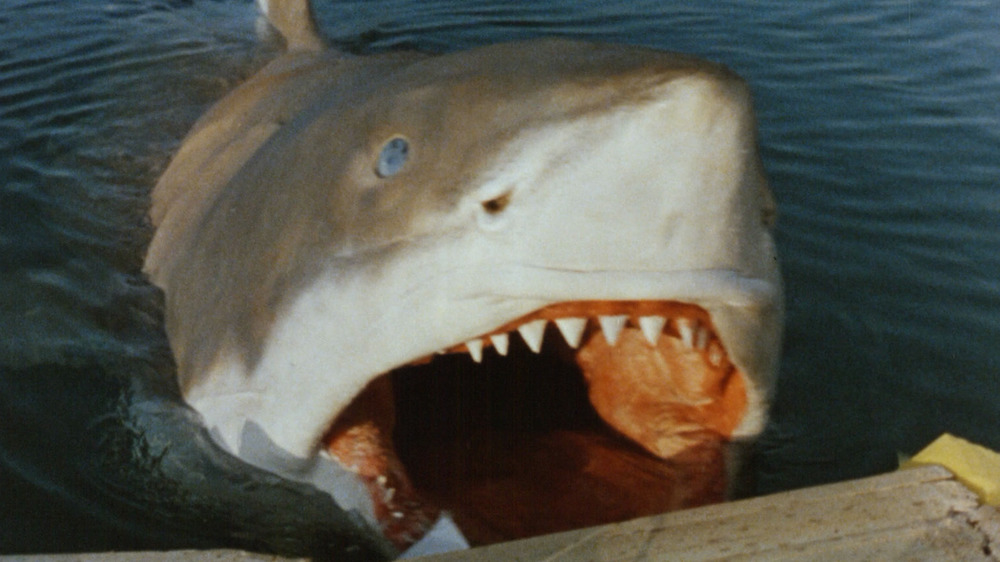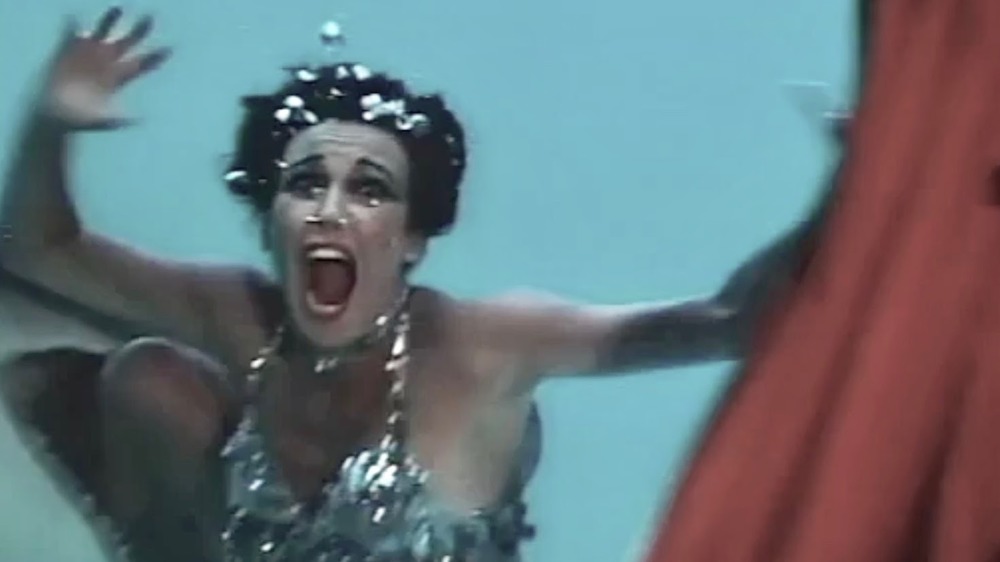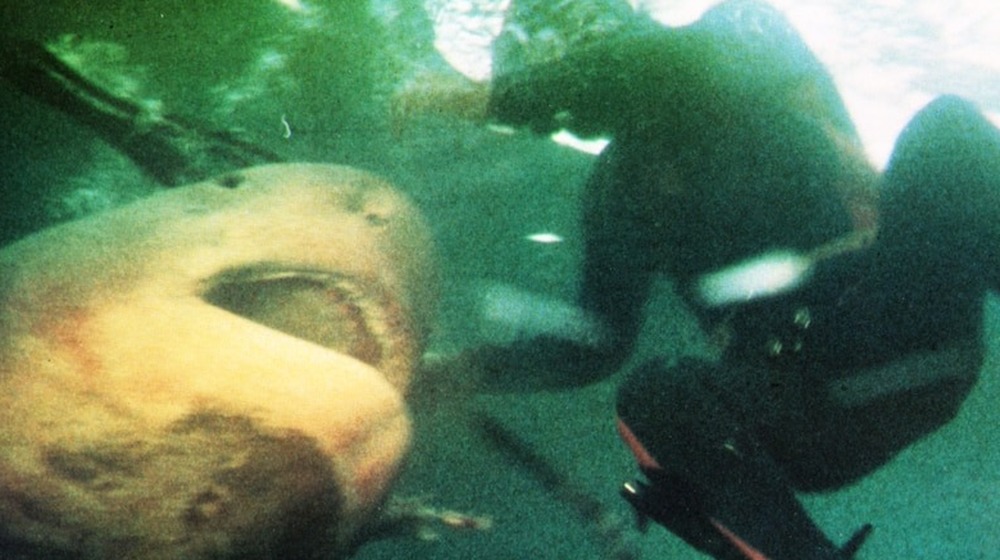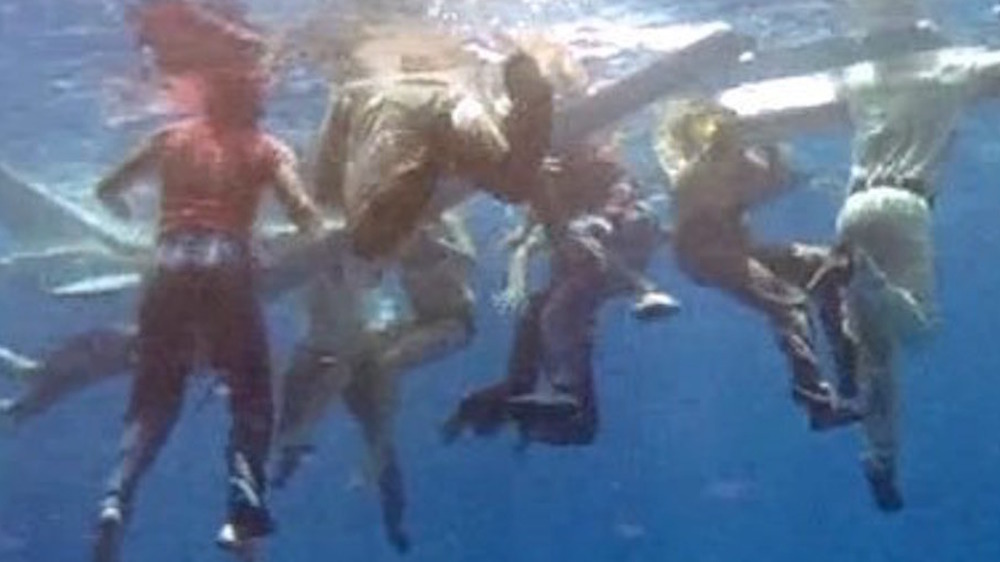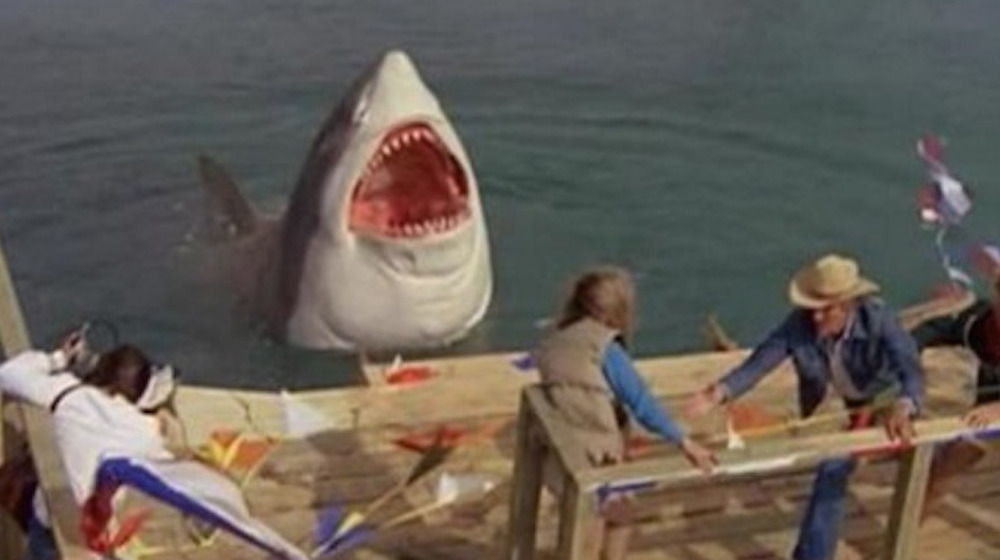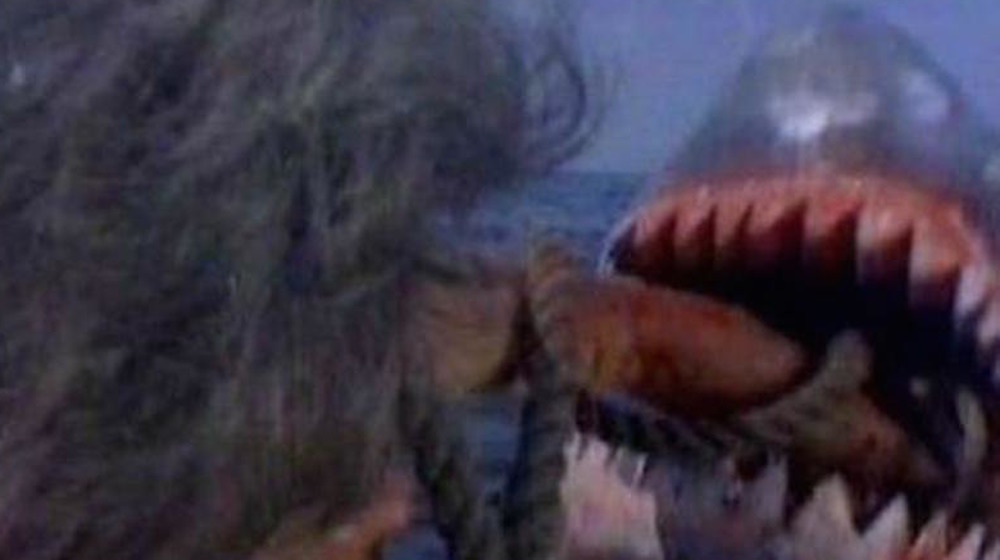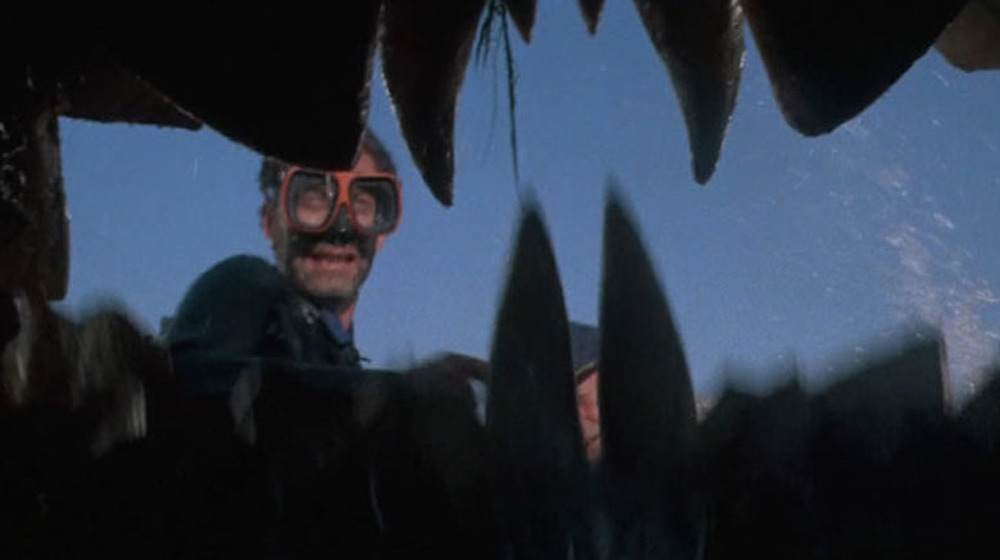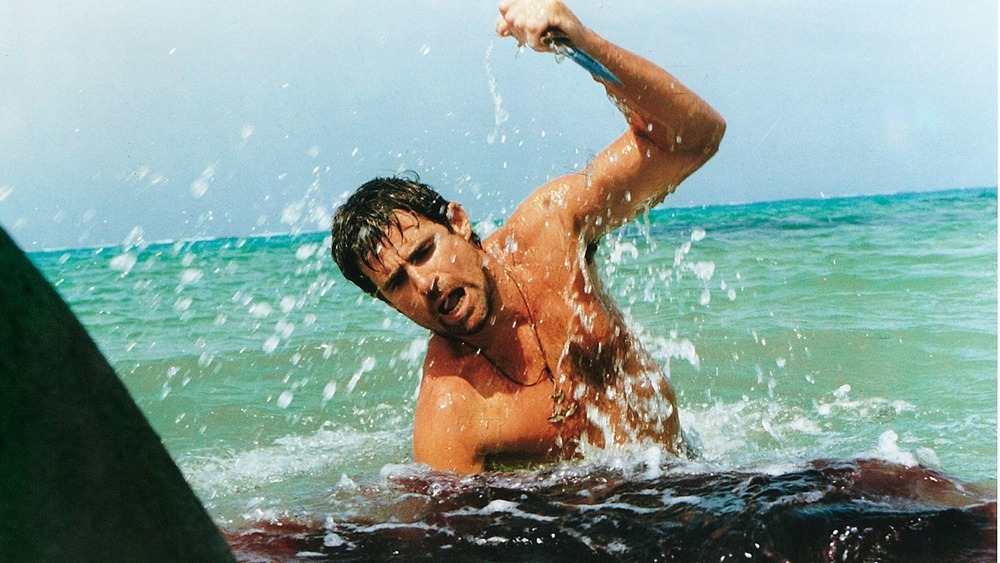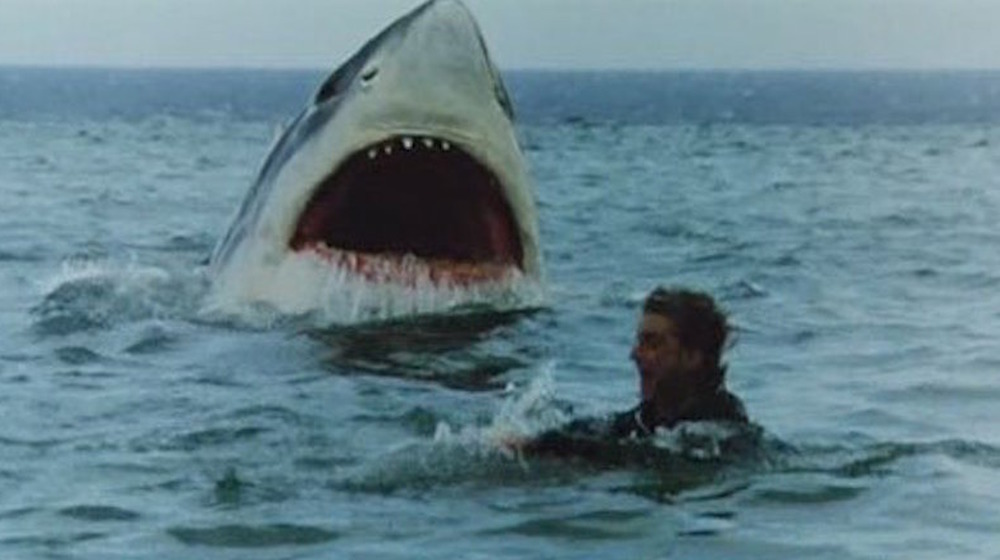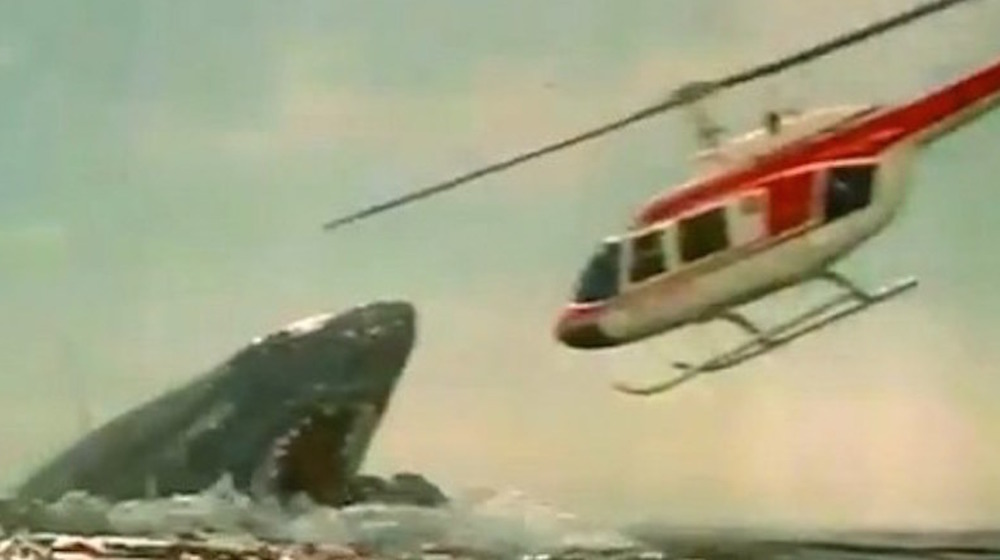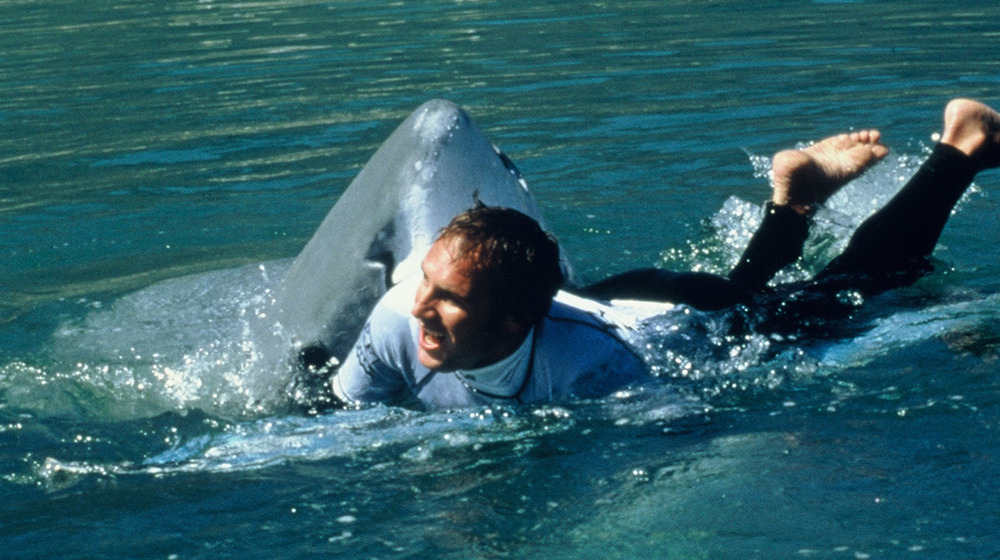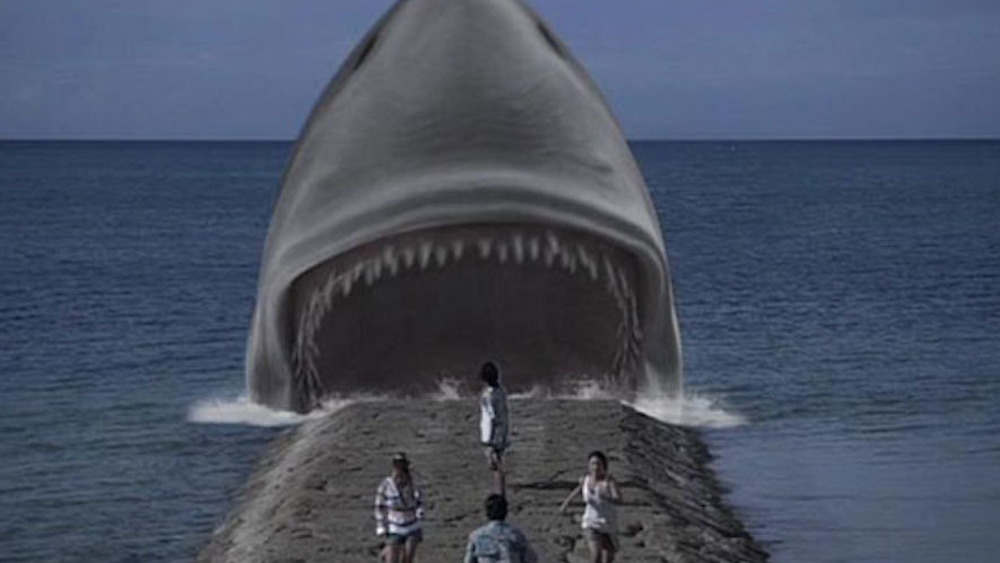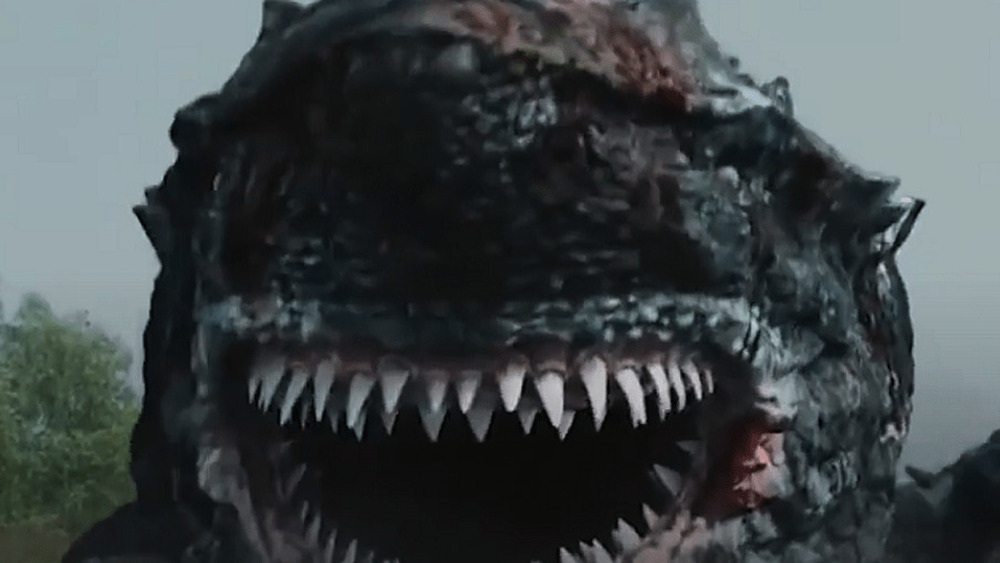The Most Bizarre Shark Movies From Around The World
As the saying goes, imitation is the most sincere form of flattery. It can also be the most profitable, especially in the film business. Enterprising (or scheming) producers have been turning out carbon copies of successful or popular movies since the first days of the motion picture industry; many of these efforts tend to be low-budget affairs, focused on delivering the "good" parts of the original without all the trouble of a script or production values.
Whole cottage industries have sprung up around zombie films, backwoods cannibal movies, teen sex comedies, and the Star Wars franchise; one of the longest-running and most prolific exploitation subgenres is the Jaws knock-off. Production companies around the world have been turning out their own shark scarefests since Steven Spielberg upended the motion picture business with his thriller in 1975, and continue to do so at an almost relentless pace: a substantial portion of SyFy's movie content is devoted to atomic sharks, ghost sharks, exorcist sharks, ice sharks, and every other possible way to put together giant hungry sharks and an unsuspecting cast of characters.
While the SyFy titles draw much of the attention — especially the deliberately "bad" Sharknado series — there are dozens of other "sharksploitation" films, some arriving not long after Jaws itself and many from other countries. Here are the strangest and most outrageous shark movies from all points on the globe.
Warning: spoilers to follow.
Florida man has psychic shark connection in Mako: The Jaws of Death
Oscar-nominated actor and dependable character player Richard Jaeckel (The Dirty Dozen) enjoyed a rare lead in the 1976 Florida-lensed oddity Mako: The Jaws of Death from hard-working grindhouse director William Grefe (Sting of Death). Jaeckel plays a loner who has a psychic connection to mako sharks — thanks to a mystical shark's tooth bestowed upon him by a Filipino shaman — and little regard for fellow humans, especially those who hunt his finned friends for sport.
At times, Mako is as out to lunch as its protagonist: a psycho-thriller with supernatural overtones and a sympathetic streak towards sharks that is upended every time Grefe shows one of them getting hooked or speared (oh, and don't forget an appearance by Harold "Oddjob" Sakata of Goldfinger fame). It does, however, feature some astonishing scenes of real sharks appearing to attack and chow down on stuntmen (Grefe directed the underwater sequences in Live and Let Die), which, along with its plot eccentricities, ultimately sets it apart from most shark exploitation efforts.
Sea, sun, and sharks in Tintorera: Killer Shark
What if Jaws had been set at a singles resort, instead of an island off the coast of New England? It would have been ridiculous, for one, but also possibly a lot like Tintorera: Killer Shark, a Mexican-British thriller from 1977. Though advertised as a horror film, director Rene Cardona, Jr. –- a prolific director of crazed exploitation films like Night of a Thousand Cats –- devotes much of the running time to businessman Hugo Stiglitz enjoying the sun and sights at a seaside resort, as well as a romantic triangle with British tourist Susan George (Dirty Mary, Crazy Larry) and swim instructor Andres Garcia.
From time to time, the action stops to note that a tiger shark is prowling the waters around the resort and eating an alarming number of the guests (including a pre-Three's Company Priscilla Barnes), but this doesn't provoke much of a response until Garcia is torn apart by the shark, which sends Stiglitz into revenge mode (and yes, Stiglitz's name was borrowed by Quentin Tarantino for Til Schweiger's character in Inglourious Basterds). Animal lovers, take note: real sharks meet real grisly ends for entertainment purposes in this sleepy South of the Border sharkfest.
Sharks plus airplane disaster = Cyclone
How do you top the terrors of Tintorera? Well, if you're director Rene Cardona, Jr., you borrow elements from the then-popular airline disaster subgenre, toss in a dose of cannibalism — a topic he covered with as little subtlety as possible in 1977's Survive! – as well as a few sharks and a handful of slumming American actors. Shake well and the result is Cyclone, a 1978 Mexican shocker about downed airplane passengers and boat tourists thrown together by a tropical storm.
Lack of food and water turns the situation dire in a hurry, resulting in some exceptionally grim moments, like the fate that befalls star Carroll Baker's pampered doggie — and that's before starvation forces the survivors to turn to cannibalism. Oh, and the boat sinks in waters infested by sharks. Based on the avalanche of bad luck that precedes this scene, you can guess what happens next. If you like your ocean thrills with a heavy dose of ugliness (though leavened by atrocious visual effects, like the budget storm that's represented here by an off-camera hose), then buckle up for a ride on Cyclone.
The Last Shark: when Jaws goes to court
While nearly all sharksploitation films crib scenes from Jaws, only one title appropriated so much of the Steven Spielberg film to warrant legal action from Universal Pictures. That's 1982's L'ultimo squalo (The Last Shark), also known as Great White and Shark. This Italian-made action-thriller bit off huge chunks of not only Jaws but also Jaws II for good measure, prompting a lawsuit from Universal that resulted in the film being pulled from American theaters. Director Enzo G. Castellari — a hard-working and capable director of European action films, including Inglorious Bastards, which inspired the Quentin Tarantino film — keeps the pace brisk and the shark-on-man action plentiful and gory.
In fact, The Last Shark might have been a wholly enjoyable effort without the constant swipes from Jaws, but imitation is often the key to success in Italian exploitation filmmaking. So we have an ersatz Chief Brody — author Peter Barton (James Franciscus), whose name is an obvious nod to author Peter Benchley – and faux Quint (Vic Morrow with a come-and-go Irish accent) battling a flimsy mechanical shark and scheming politician Joshua Sinclair. The effects are hit and miss — the shark's attack on a helicopter is pure bathtub toy action — but the few original elements are inventive bits of grindhouse ingenuity, like Franciscus feeding Morrow's corpse, wrapped in dynamite, to the shark.
Col: crazy shark action from Turkey
Admittedly, 1983's Turkish thriller Col (Desert) is primarily a revenge vehicle for its brawny lead, veteran action star Cuneyt Arkin. But it's included here because of a scene in which Arkin battles a shark. Arkin, who plays a hired killer, betrays his old bosses and is beaten and left to die in the ocean. While struggling to regain consciousness, he is attacked by what we are asked to believe is a hungry shark, but appears instead to be a large plastic or fiberglass shark model with a stiff but ever-flapping maw (it's reminiscent of the Ideal Toy Company's "Game of Jaws" from 1975), reportedly operated by director Cetin Inanc. Then, to the unauthorized strains of John Williams' score for Jaws, Arkin finds a knife and stabs his rigid opponent, sending it to a watery grave.
The rest of the movie is concerned with Arkin's revenge, but for one brief and hallucinatory moment, it's the best man-vs.-toy-shark scene ever, and why the film is known as Turkish Jaws in English-speaking cult movie circles. And in case you're wondering why the movie is called Desert: according to popular legend, the film's original title was Blue Desert – a reference, one assumes to the vast openness of the ocean — but the printer tasked with creating the one-sheet allegedly didn't understand the title, and simply shortened it to Col. Which makes even less sense, as there's no desert in the picture.
Before there was Sharktopus, there was Monster Shark
Take that, Sharktopus: this 1984 Italian-French co-production unleashed a half-shark, half-octopus monster on unsuspecting swimmers nearly three decades before the launch of Roger Corman's creature feature franchise. Technically, the Monster Shark isn't a shark at all, but rather a Dunkleosteus, a prehistoric armored fish with a crushing bite, that's been genetically combined with an octopus as part of a secret military experiment (the film's alternate titles, which include Devil Fish and Red Ocean, avoid this problem altogether).
It's unlikely that anyone asked for a refund based on inaccurate binomial nomenclature, especially when they were treated to scenes of Italian actors being throttled by tentacles and bitten in half. For Eurocult fans, Monster Shark is also something of an all-star production: director Lamberto Bava –- son of Italian horror pioneer Mario Bava – also oversaw the popular Demons films, while screenwriters Dardano Sacchetti and Gianfranco Clerici penned pictures for Dario Argento and Lucio Fulci, among others. Meanwhile, the story is credited to Luigi Cozzi — who directed the infamous Star Wars knockoff Starcrash as well as Hercules with Lou Ferrigno — and Sergio Martino, whose credits include a long list of gialli and Continental crime films.
Night of the (very laid-back) Sharks
There's just one shark in Night of the Sharks, which more or less sums up this 1988 Italian/Spanish/Mexican production. It's loosely built around a story that pits Treat Williams, an American beach bum hanging out in the Dominican Republic, against sinister types (prolific Eurocult players John Steiner and Chris Connelly) seeking incriminating evidence stolen by his brother.
Like its main character, Night of the Sharks is in no real hurry to generate any sort of tension: Williams, a talented but perennially undervalued actor, is fun in a sort of proto-Lebowski role, and from time to time, he tangles with a sizable, one-eyed shark he's dubbed "Cyclops." But this is no Ahab/white whale situation: Cyclops occasionally tosses Williams a lifeline by eating his pursuers, and for the most part, their relationship can be best described as mutually irritating, as if both were appearing in an island-set production of The Odd Couple. There is one impressive underwater scene in which Williams (or his stuntman) tangles with a real shark, but for the most part, this is the mellowest sort of sharksploitation.
Cruel Jaws is the funniest Jaws rip-off (though not on purpose)
Perhaps the most egregious example of sharksploitation is 1995's Cruel Jaws, a U.S.-Italian feature that takes the subgenre's willful theft of material from Jaws to a whole new level of larceny. The film, directed by Bruno Mattei – one of Italian genre film's most unrepentant hacks — not only lifts whole chunks of plot and dialogue from Jaws for its by-the-numbers premise (hungry tiger shark threatens a small coastal town and its money-making regatta), but also swipes actual (and undoubtedly unauthorized) footage from the Spielberg film, as well as Jaws 2 and even The Last Shark!
Having said that, Cruel Jaws is also one of the more amusing monster shark movies, even though the humor is almost entirely unintentional: when Mattei isn't stitching together the shark attack scenes from a haphazard mix of original and stolen footage, he devotes an inordinate amount of running time to the town mayor's goofball of a son and his equally dim-witted pal as they pursue girls on the beach. Thankfully, they become meals for some stock footage of sharks.
Aatank is Bollywood's contribution to sharksploitation
Like many South Asian genre movies, the Hindi feature Aatank (Terror) has a lot on its plate. The film -– released in 1996 but filmed at least a decade earlier — is, at various times, a coming-of-age story, a gangster drama, a romance, and an action picture, while also finding room for several full-blown Bollywood musical numbers. With so many subplots vying for your attention, it's easy to forget that Aatank is also a horror movie featuring a giant killer shark. But once the monster turns up (around the picture's midpoint), Aatank shifts into pure sharksploitation.
The shark, which appears to be twice the size of the monster in The Meg and given to emitting human-like howls (really), immediately establishes its star power by devouring both the film's second lead and his new bride and taking down a helicopter and the film's bad guy in a single move (how do you like that, Jaws 2?) before facing the film's hero, Indian actor star Dharmendra. You may want to take precautions before viewing the finale, which could cause serious damage after your jaw hits the floor.
Shark Attack 2 pits sharks against a fake Steve Irwin
If you were an enterprising producer looking to borrow from one of the Jaws films for your own homegrown sharksploitation effort, which would you "adapt"? Surely not Jaws: The Revenge – you're not crazy — but would you lift the marine park setting from Jaws 3-D? Probably not — unless, of course, you were making Shark Attack 2.
Much of this U.S.-South African feature from 2000 takes place at Water World, a sprawling ocean-themed park in Cape Town. There, the unscrupulous businessman owner decides that Water World's next big attraction is a Great White, and taps an Australian TV host (a fairly sour spoof of Steve Irwin) to capture the animal. Unfortunately, said shark is not only one of the genetically altered super-sharks from the first Shark Attack, but it's also joined by five other finned freaks of science. What follows is the inevitable shark cage match and a lot of hilarious attempts at tough guy talk, but the real takeaway from Shark Attack 2 is that it generated Shark Attack 3, starring John Barrowman of Doctor Who and Torchwood fame.
Sharks and serial killers in Jaws in Japan
For one brief, shining moment, the 2009 Japanese horror film Jaws in Japan drew international attention by being mentioned as part of a Vanity Fair article on the lasting cultural influence of Jaws. Unfortunately, the film is described as "immediately forgotten," and for the most part, that seems to be the fate of this odd mix of shark terror and serial killer chills. The scant press that the film has generated notes that these two elements really don't mix at all, though the serial killer stuff could be considered mildly creepy — two vacationing college students discover footage of a murder left on a video camera — and the shark itself, which shows up in the final minutes of the movie, appears to be the size of a football stadium.
Most reviews seem to disparage the film for having nothing to do with Jaws – though, as we've seen, that hasn't stopped many sharksploitation titles — and for its apparent and steadfast determination to keep the two leads firmly ensconced in their many bathing suits. Of course, retitling the movie Psycho Shark doesn't seem to have helped matters either.
Knock! Knock! It's China's Land Shark
The 2020 Chinese sci-fi thriller Luxingsha (Land Shark) appears to be the latest evolution in a curious sub-subgenre of the shark horror film: the flying killer shark. Not satisfied with the simple pleasures of watching enormous sharks devour supporting players in the water, enterprising filmmakers have allowed their finned fiends to take to the skies a la the Air Jaws documentary series.
Results have ranged from the ridiculous (Sharknado) to the completely ridiculous (Sky Sharks, which pairs flying sharks with Nazi zombies), but Land Shark – which should not be confused with the low-budget 2017 American film of the same name, and features sharks cruising through sand — appears to up the ante by also allowing its sharks to not only sail through the air but also travel on land to devour their castmates. Genetic testing is once again the culprit, this time administered by a devious pharmaceutical company. Land Shark has yet to see an American release date, but judging by the available trailers, it's only a matter of time.
